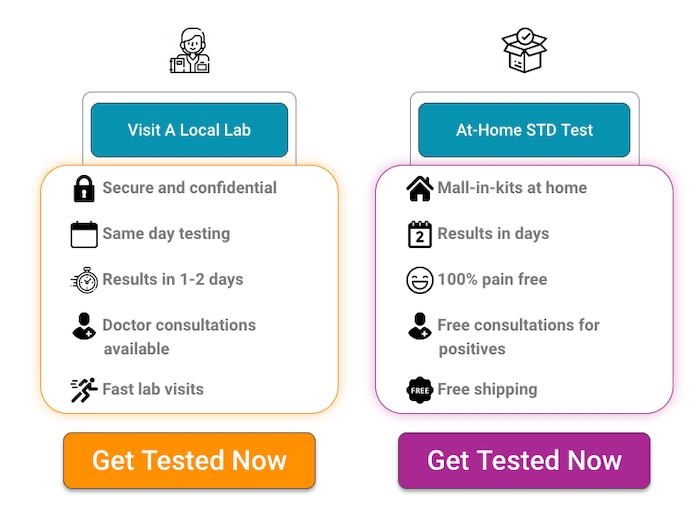The US is experiencing a steady increase in cases of oral herpes. About 50% to 80% of the US population are infected with oral herpes. Herpes is caused by the herpes simplex virus and is of two types – HSV-1 and HSV-2. Also known as a fever blister or a cold sore, oral herpes or HSV-1 is very common. It is more common than genital herpes or HSV-2. Approximately about 90% of the sexually active adult population have contracted oral herpes by the age of 50. The only way to keep the rate of oral herpes infection under control is to get tested for potential HSV-1.
Worldwide, about 3.7 billion people were infected with oral herpes. This accounts for 66.6% of the world’s population under the age of 49. Oral herpes is easily transmitted by coming in intimate contact with an infected person. It is spread through oral contact and affects the mouth and the area surrounding it. Sometimes, HSV-1 can also lead to genital herpes when a person practices mouth to genital sexual acts. Genital HSV-1 accounts for 122 to 192 million cases worldwide. As more cases are detected, panic spreads across the world among sexually active individuals.

Oral herpes can be hard to diagnose as it can be mistaken for another STD. That is why a proper HSV-1 test should be conducted to determine whether or not a person is infected. Oral herpes test is effectively conducted with PCR, biopsy, or blood test. The infection can be managed with oral antiviral medication. Getting tested for oral herpes has become relatively easy with online STD stores. It has become quite easy for anyone to test for oral herpes in the US. Many online STD stores have partnered with reputed STD labs and facilities that account for more than 4,500 centers. These online STD stores offer effective and discreet STD testing where all you need to do is find and book the desired order.
In a CDC report between 2015 and 2016, there was a spike in the cases of both oral herpes and genital herpes among people between 14 to 49 years in the US. The study shows that nearly 48% of the said age group are infected with oral herpes, while 12% account for genital herpes. Among the cases reported, the older people between the ages of 40 and 49 hold the most cases with 60% and 21% of HSV-1 and HSV-2, respectively. The number of cases reported in people between 14 and 19 years stood at 27% and 0.8% for HSV-1 and HSV-2, respectively.
Both oral and genital herpes cases have seen low rates from 1999 to 2016, with HSV-1 and HSV-2 cases declining by 11% and 6%, respectively. However, during the 2015-2016 time frame, oral herpes has an infection rate of 47.8%. More cases of both HSV-1 and HSV-2 were reported in females than males. Females reported an infection rate of 50.9% in females and 45.2% in males. Oral herpes prevalence rate varies by disproportionate measures depending on racial/ethnic groups. The highest rate of oral herpes infection was reported among Mexican-Americans with 71.7%, while the non-Hispanic white people accounted for the least cases of HSV-1 at 36.9%. Non-Hispanic Asian people and non-Hispanic Black people have a prevalence rate of 55.7% and 58.8%, respectively.
The incidence rate of both oral and genital herpes increases with age. People between 14 and 19 years account for 27.0% of cases of HSV-1. Those between the age of 20 to 29 and 30 to 39 have a prevalence rate of 41.3% and 54.1%, respectively. If you are experiencing symptoms like rashes or sores in and around your mouth or if you think you may have been exposed to the infection recently, don’t hesitate to get tested. Aside from appointments with the nearest STD testing centers, many online STD websites also offer at-home STD testing kits where you can get tested for oral herpes at home. You can either opt for a lab visit or an at-home STD testing kit. However, make sure to get tested in time to avoid possible health hazards in the future.
The herpes simplex virus stays with a person for life once infected. Therefore it is advisable for every sexually active person to practice safe sex by using protection, limiting sexual partners, and getting routine tests. If you or an infected person you know is experiencing an outbreak of sores and blisters, try to limit contact with other people until the outbreak recedes. Although there is no effective cure for oral herpes, certain medications can help in relieving the symptoms by reducing outbreaks and limiting the chance of transmission.
A lot of people with HSV-1 don’t experience any outbreaks or symptoms and can feel quite healthy. However, they still carry the risk of transmission to other people during sexual activities that include oral sex and kissing during active outbreaks. Many oral herpes cases are acquired during infancy when the saliva of an infected person comes in contact with the skin of the baby while kissing them. Some people may experience periodic outbreaks of sores and blisters in and around the mouth. Sometimes, sores or blisters can develop inside the mouth, cheek, chin, and even nose. Oral herpes is most contagious when a person is having an active outbreak.
Being diagnosed with oral herpes can lead anyone into a state of despair. But remember that having the infection for life doesn’t mean you can never have a normal sexual life. Many people diagnosed with oral herpes go on to live long and healthy lives. The most important thing is to get diagnosed early so that the treatment process can be more simple and successful. With the rising cases of oral herpes cases in both the US and the world, there is an immediate need to get tested. Getting tested on time saves anyone from complicated future health issues.


